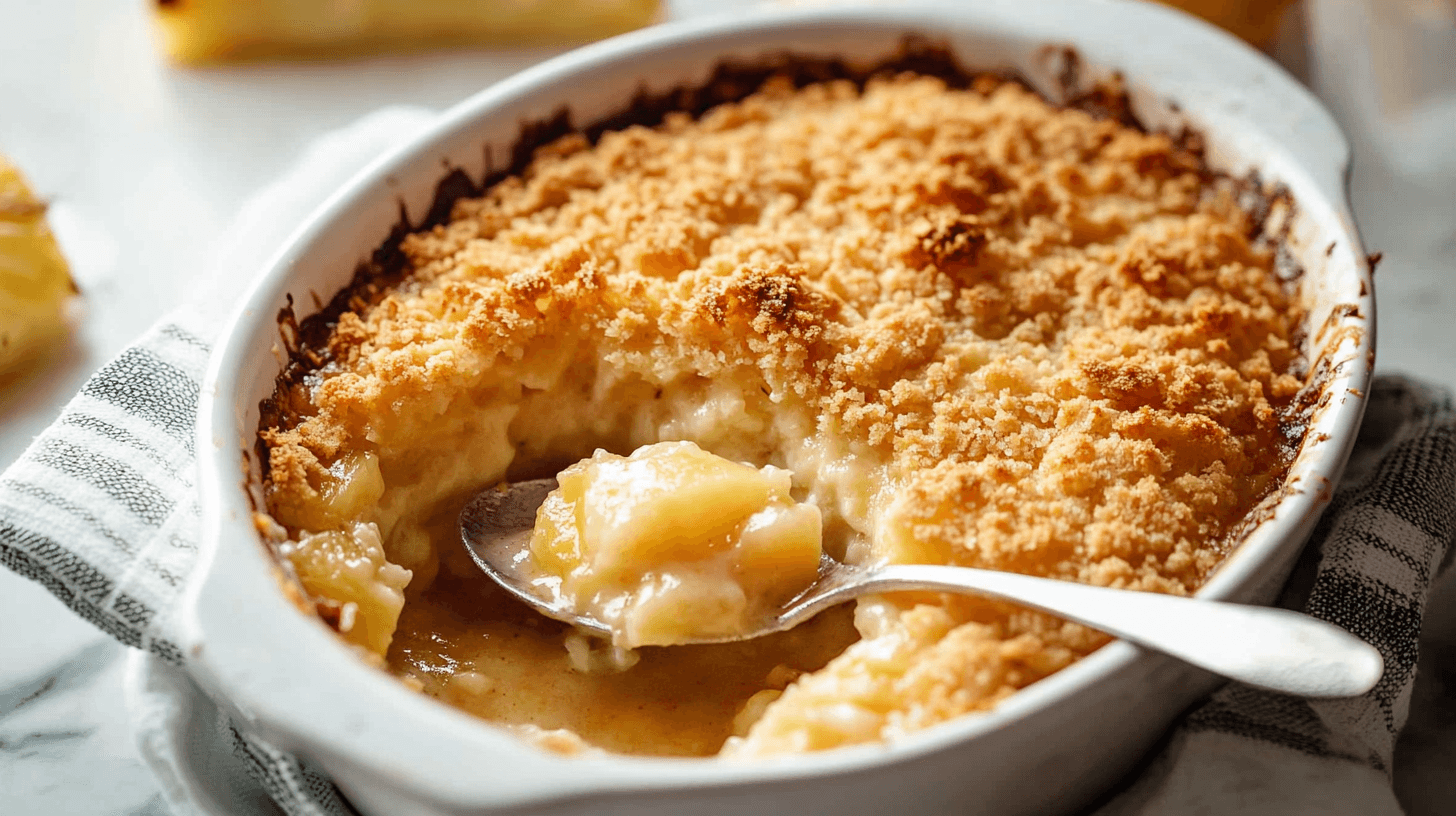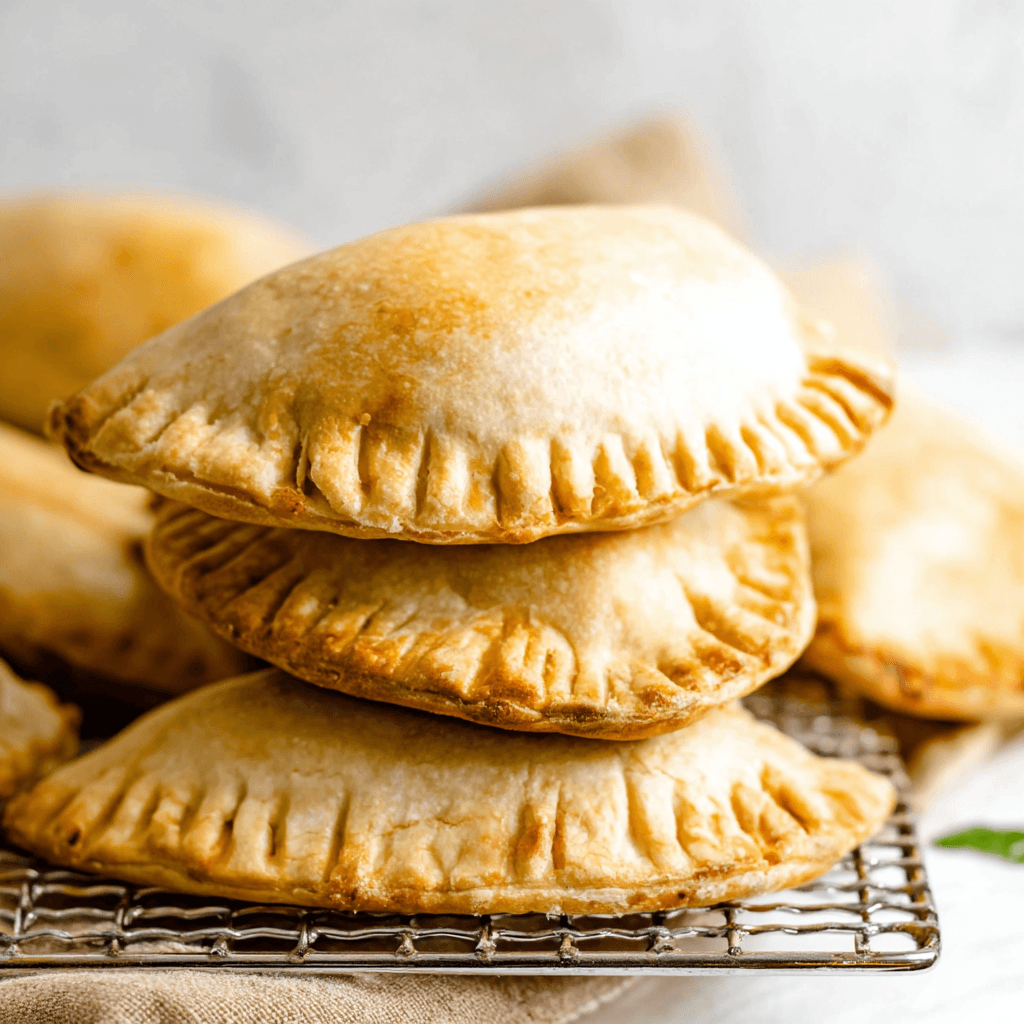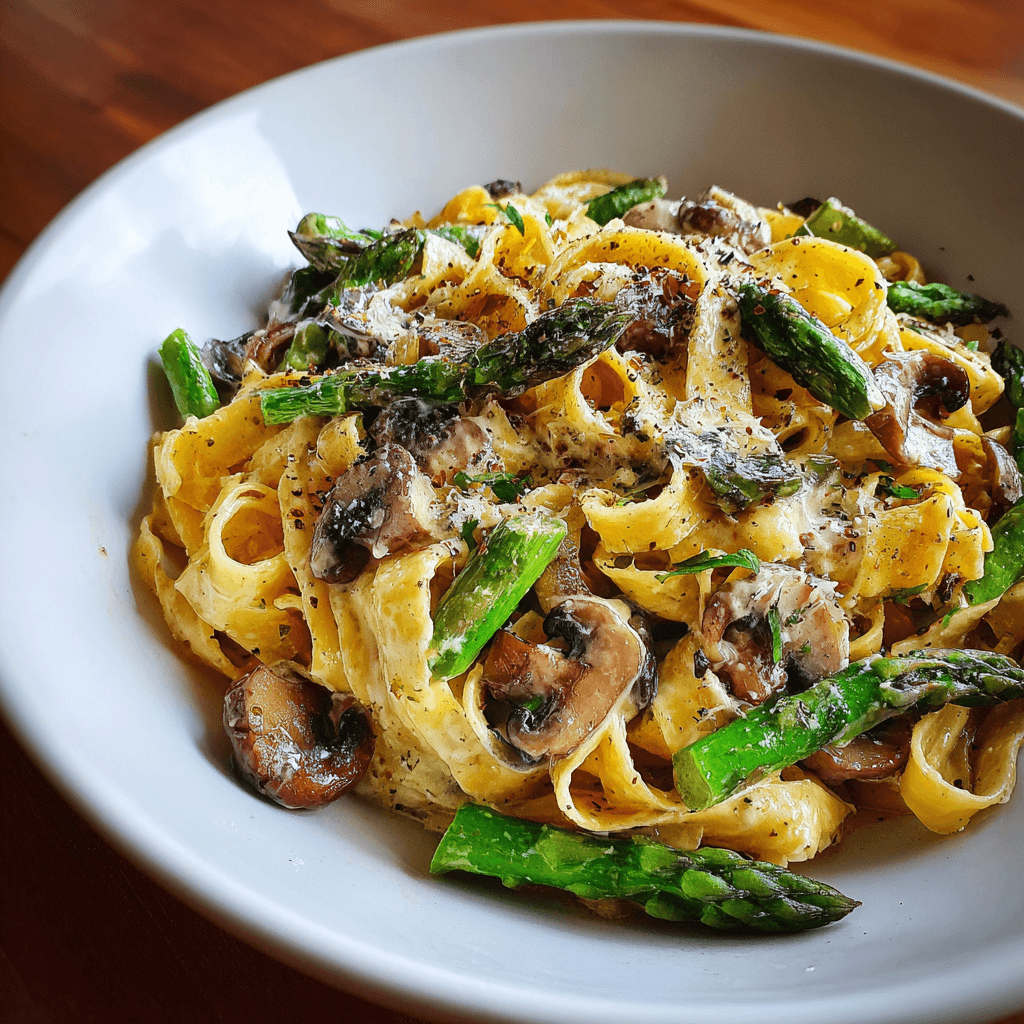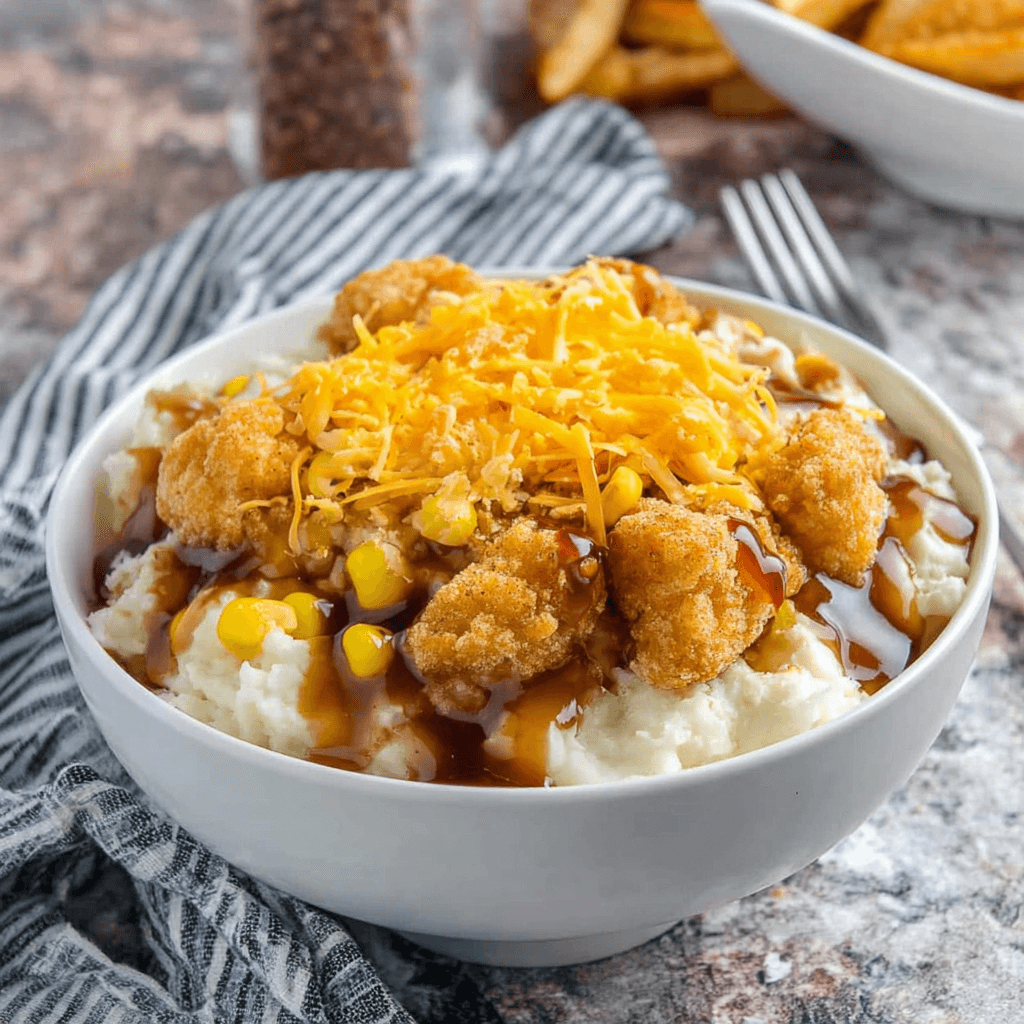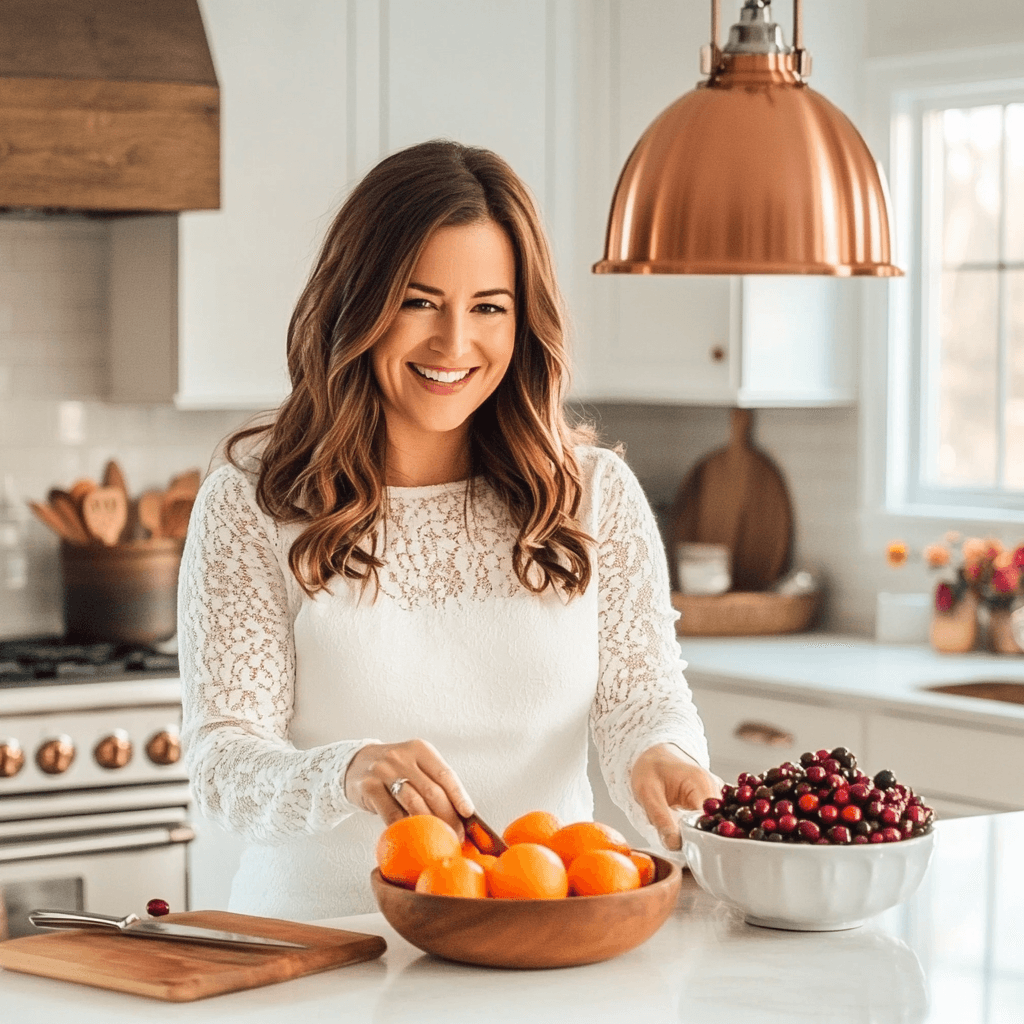Table of Contents
Introduction
What Makes Pineapple Casserole Unique
Pineapple Casserole recipe is a delightful Southern classic that surprises and delights with its unexpected combination of ingredients. This dish blends the sweetness of pineapple with the buttery crunch of crackers and the richness of cheese, creating a casserole that’s perfect for special occasions, potlucks, or as a unique side dish. Its distinct combination of flavors and textures makes it a standout addition to any meal.
The Blend of Sweet and Savory Flavors
The magic of pineapple casserole lies in its balance of sweet and savory elements. The natural sweetness of the pineapple pairs beautifully with the tangy sharpness of cheddar cheese, while the buttery cracker topping adds a satisfying crunch. This harmonious medley of flavors creates a dish that’s as comforting as it is intriguing, offering a memorable taste experience that keeps people coming back for more. Whether served alongside a savory ham or as a dessert-like treat, pineapple casserole is a versatile recipe that always surprises and delights.
Ingredients Overview
Fresh or Canned Pineapple: Which to Use
The choice between fresh and canned pineapple depends on your preference and convenience:
- Canned Pineapple: A traditional choice for this casserole, canned pineapple provides consistent sweetness and a soft texture that blends seamlessly with other ingredients. Opt for pineapple chunks or tidbits in juice (not syrup) to control the sweetness.
- Fresh Pineapple: For a brighter, more natural flavor, fresh pineapple is an excellent option. Dice it into small chunks and ensure it’s ripe for optimal sweetness. Keep in mind that fresh pineapple may require slightly more preparation time.
Essential Ingredients: Cheese, Crackers, and Butter
The core components of pineapple casserole contribute to its unique flavor and texture:
- Cheese: Sharp cheddar cheese is a must for this dish. Its tangy flavor balances the sweetness of the pineapple, creating the perfect sweet-savory combination.
- Crackers: Buttery crackers, such as Ritz, are crumbled to form the topping. They provide a crisp, golden layer that contrasts beautifully with the soft pineapple filling.
- Butter: Melted butter is mixed with the cracker crumbs to bind the topping and enhance its richness.
Optional Add-ins for Texture and Flavor
Customize your pineapple casserole with these optional ingredients:
- Nuts: Chopped pecans or walnuts add a nutty crunch to the topping.
- Spices: A pinch of cinnamon or nutmeg can add warmth and depth to the dish.
- Dried Fruit: Add raisins or dried cranberries for an extra layer of sweetness and texture.
- Herbs: A touch of fresh thyme or rosemary can elevate the savory elements if you prefer a more unique flavor profile.
These carefully chosen ingredients create a harmonious balance of flavors and textures, making pineapple casserole a delightful dish that’s sure to impress.
Kitchen Tools Needed
Basic Tools: Mixing Bowls, Baking Dish, and Whisk
To prepare a pineapple casserole, these basic kitchen tools are essential for a smooth and efficient cooking process:
- Mixing Bowls
- Use separate bowls for combining the pineapple mixture and preparing the buttery cracker topping.
- Baking Dish
- A medium-sized baking dish (8×8 or 9×13, depending on the portion) is ideal for layering and baking the casserole. Opt for a glass or ceramic dish for even heat distribution.
- Whisk
- A whisk is useful for blending the pineapple juice with sugar or any spices you choose to incorporate, ensuring a smooth consistency.
Optional Tools: Food Processor for Even Crumbs
For a more uniform and professional finish, consider these optional tools:
- Food Processor
- Use a food processor to quickly and evenly crush crackers for the topping. This ensures a consistent texture and even browning.
- Grater
- If you’re using block cheddar cheese, a grater makes shredding fast and easy, allowing the cheese to melt evenly into the casserole.
- Rubber Spatula
- A spatula is ideal for scraping the mixing bowls clean and evenly spreading the pineapple mixture and topping in the baking dish.
These tools, whether basic or optional, help streamline the preparation process, ensuring your pineapple casserole turns out perfectly every time.
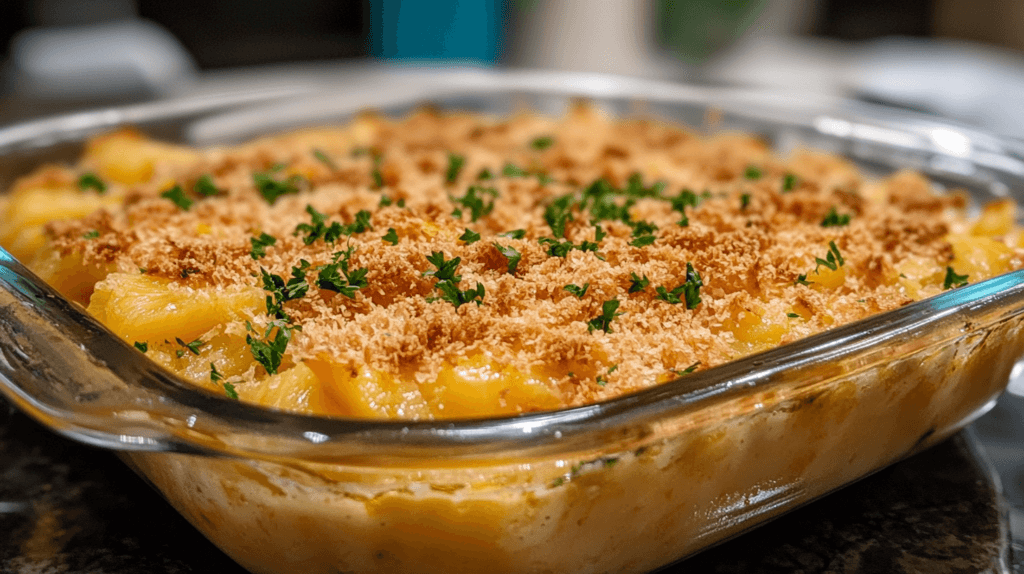
Ingredients List
For the Pineapple Casserole
- 2 (20 oz) cans pineapple chunks (drained, reserve ½ cup juice)
- ½ cup granulated sugar
- ¼ cup all-purpose flour
- 2 cups shredded sharp cheddar cheese
For the Buttery Cracker Topping
- 1 sleeve Ritz crackers (about 30 crackers, crushed)
- ½ cup unsalted butter (melted)
Preparing the Pineapple
Draining Pineapple for Perfect Consistency
Properly draining the pineapple is crucial to achieve the right consistency in your casserole. Excess liquid can make the dish watery and compromise its texture. Follow these steps for perfectly prepared canned pineapple:
- Use a Strainer
- Pour the pineapple chunks or tidbits into a fine-mesh strainer to remove excess juice. Let it sit for a few minutes to ensure thorough drainage.
- Press Gently
- Use the back of a spoon to gently press the pineapple in the strainer, extracting additional juice without mashing the fruit.
- Save the Juice
- Reserve a small amount of the drained juice if the recipe calls for it to blend with sugar or spices for added flavor.
Tips for Fresh Pineapple Preparation
If you’re using fresh pineapple, preparing it correctly ensures optimal sweetness and texture:
- Selecting a Ripe Pineapple
- Choose a pineapple with golden skin and a sweet aroma at the base. The leaves should be green and easy to pull from the top.
- Peeling and Coring
- Slice off the top and bottom of the pineapple. Stand it upright and carefully cut away the skin, following the curve of the fruit. Remove the tough core by cutting the pineapple into quarters lengthwise and slicing it out from each section.
- Cutting into Chunks
- Dice the pineapple into small, bite-sized chunks for even distribution in the casserole.
- Juicing Option
- If fresh pineapple releases excess juice while cutting, strain and reserve it for blending with other ingredients in the recipe.
By properly draining canned pineapple or preparing fresh pineapple with care, you ensure that your casserole has the ideal balance of flavors and textures, avoiding any unwanted sogginess.
Mixing the Casserole Base
Combining Pineapple, Sugar, Flour, and Cheese
The casserole base is the heart of the dish, bringing together sweet, savory, and creamy elements. Here’s how to mix it perfectly:
- Prepare the Ingredients
- Pineapple: Use properly drained pineapple chunks or tidbits, ensuring they are free of excess liquid.
- Sugar: Add granulated sugar to balance the tangy sweetness of the pineapple. Adjust the amount to your preference.
- Flour: Sprinkle all-purpose flour into the mixture to act as a thickening agent, ensuring the casserole holds its shape after baking.
- Cheese: Incorporate freshly grated sharp cheddar cheese for a tangy, creamy contrast to the sweetness.
- Mix the Base
- In a large mixing bowl, combine the pineapple, sugar, and flour. Toss gently until the pineapple pieces are evenly coated.
- Add the grated cheese and fold it into the mixture, ensuring it is evenly distributed without breaking the pineapple chunks.
Ensuring Even Mixing and Consistency
To achieve a smooth and uniform casserole base:
- Use a Large Bowl
- A spacious mixing bowl gives you room to combine ingredients without spilling or crushing the pineapple.
- Toss Gently
- Avoid overmixing or mashing the pineapple. Use a wooden spoon or rubber spatula to fold the ingredients together gently.
- Check Consistency
- The mixture should be evenly coated, with no visible dry flour or clumps of cheese. If it feels too dry, add a tablespoon of reserved pineapple juice or a splash of milk to loosen it slightly.
- Taste Test (Optional)
- Before transferring the mixture to the baking dish, taste it to ensure the sugar and cheese balance meets your preference.
By carefully combining the pineapple, sugar, flour, and cheese, and ensuring even mixing, you’ll create a well-balanced and flavorful base for your pineapple casserole.
Creating the Topping
Choosing the Right Crackers: Ritz vs. Alternatives
The topping is a crucial component of pineapple casserole, providing a buttery crunch that contrasts beautifully with the soft and creamy base. Here’s how to choose the best crackers:
- Ritz Crackers
- The classic choice for pineapple casserole, Ritz crackers are buttery, slightly salty, and crumble easily, making them perfect for the topping. Their rich flavor enhances the dish’s savory profile.
- Saltines
- For a lighter, less buttery alternative, saltines can be used. They offer a similar crunch but with a subtler flavor.
- Panko Breadcrumbs
- For a more neutral option, panko breadcrumbs can substitute crackers, providing a crispy topping without altering the flavor profile significantly.
- Gluten-Free Crackers
- If you’re making a gluten-free version, opt for gluten-free crackers with a similar buttery flavor to Ritz.
Preparing the Buttery Crumb Topping
A well-made crumb topping adds the perfect crunch to your pineapple casserole. Here’s how to prepare it:
- Crush the Crackers
- Place crackers in a resealable plastic bag and crush them into coarse crumbs using a rolling pin or your hands. Alternatively, use a food processor for uniform crumbs.
- Melt the Butter
- Melt unsalted butter in a small saucepan or microwave-safe dish. Use just enough butter to coat the crumbs evenly without making the topping too greasy.
- Combine Crackers and Butter
- In a bowl, mix the crushed crackers with the melted butter until the crumbs are fully coated. The mixture should be moist but not overly wet.
- Optional Add-Ins
- For added flavor and texture, stir in chopped nuts like pecans or walnuts, or sprinkle in a pinch of cinnamon or nutmeg.
- Spread Evenly
- Sprinkle the buttery crumb mixture evenly over the top of the casserole base, ensuring full coverage for a uniform, golden-brown topping after baking.
By choosing the right crackers and preparing a perfectly balanced buttery crumb topping, you’ll add a delicious crunch that complements the sweet and savory flavors of the pineapple casserole.
Baking the Casserole
Ideal Oven Temperature and Timing
To bake your pineapple casserole to perfection, follow these guidelines for temperature and timing:
- Preheat the Oven
- Set your oven to 350°F (175°C), which ensures even baking without drying out the casserole.
- Bake Time
- Place the casserole dish on the middle rack and bake for 25–30 minutes. The timing may vary slightly depending on your oven, so monitor closely.
- Test for Doneness
- The casserole is ready when the edges are bubbling, and the topping is golden brown. Avoid overbaking, as it can dry out the casserole.
Achieving a Golden, Crispy Topping
For a topping that’s perfectly crisp and golden:
- Ensure Even Distribution
- Spread the crumb topping evenly over the casserole base to ensure it browns uniformly.
- Use Broil (Optional)
- If the topping isn’t golden enough after baking, switch to broil for 1–2 minutes. Watch carefully to prevent burning.
- Let It Rest
- After removing the casserole from the oven, let it rest for 5–10 minutes. This allows the flavors to meld and the texture to set before serving.
Variations to Try
Adding Pecans for Crunch
Enhance the texture and flavor of your casserole by incorporating chopped pecans:
- Mix the pecans into the buttery cracker topping for a nutty crunch.
- Alternatively, sprinkle them over the casserole before adding the crumb topping for an extra layer of texture.
Making it Spicy with a Hint of Cayenne
For a subtle kick, add cayenne pepper:
- Mix ¼ teaspoon of cayenne pepper into the flour and sugar mixture for a spicy contrast to the sweet pineapple.
- Start with a small amount, and adjust to taste for a balanced heat level.
Tropical Twist: Adding Coconut Flakes
Give your casserole a tropical flair with coconut:
- Sprinkle sweetened or unsweetened shredded coconut into the pineapple mixture for added texture and flavor.
- Alternatively, mix coconut flakes into the crumb topping for a toasty, golden layer with a hint of sweetness.
These variations allow you to customize your pineapple casserole, adding unique flavors and textures that make the dish your own. Whether you prefer a nutty crunch, a spicy kick, or a tropical touch, these ideas ensure your casserole is always exciting and delicious.
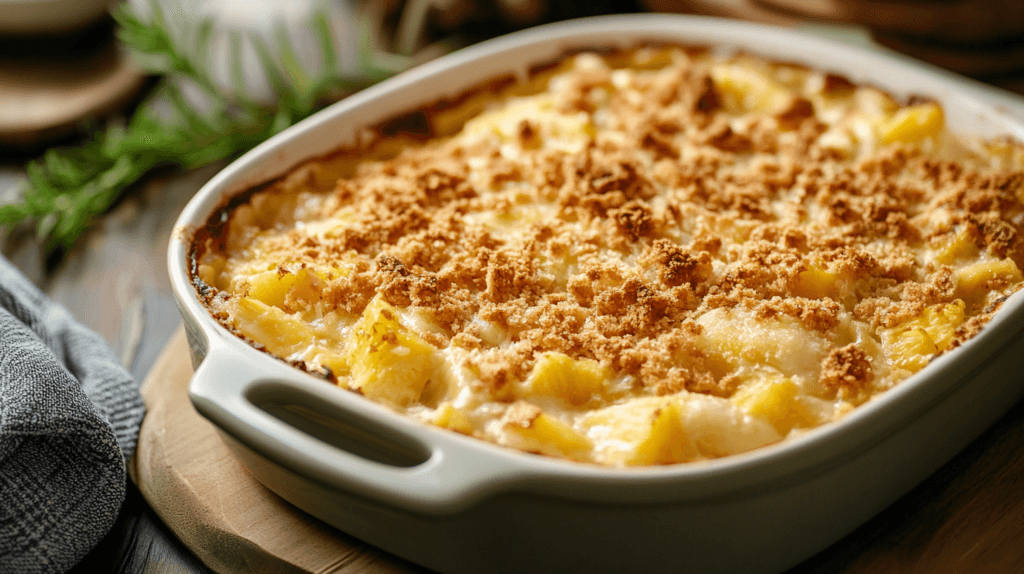
Serving Suggestions
Best Pairings: Ham, Roasted Chicken, or Grilled Vegetables
Pineapple casserole is versatile and pairs beautifully with various main dishes and sides:
- Ham
- The sweet and savory flavors of pineapple casserole complement the saltiness of baked or glazed ham, making it a popular pairing for holiday meals.
- Roasted Chicken
- Serve alongside juicy, herb-roasted chicken for a comforting and balanced meal.
- Grilled Vegetables
- The casserole’s sweetness contrasts well with smoky, charred vegetables like zucchini, asparagus, or bell peppers, creating a flavorful vegetarian-friendly plate.
Creative Ways to Serve: Side Dish or Dessert
- Side Dish
- Pineapple casserole works perfectly as a side dish for savory meals, adding a sweet and tangy contrast to proteins like pork or poultry.
- Dessert
- Its sweet elements make it a unique dessert option. Top with whipped cream or a scoop of vanilla ice cream for an indulgent treat. For a dessert to complement the pineapple casserole, the Pineapple Pie Recipe is a must-try.
- Brunch Addition
- Serve it as part of a brunch spread alongside quiches, bacon, and fresh fruit for a delightful mix of sweet and savory flavors.
Pair your casserole with a protein like the Chipotle Steak Recipe.
Tips for Storing Leftovers
Refrigerating and Reheating Properly
To keep your pineapple casserole fresh and delicious for future servings:
- Cool Completely
- Allow the casserole to cool to room temperature before storing to avoid condensation and sogginess.
- Store in an Airtight Container
- Transfer leftovers to an airtight container or cover the baking dish tightly with plastic wrap or aluminum foil.
- Refrigerate
- Place the container in the refrigerator, where the casserole will stay fresh for up to 3–4 days.
- Reheat Properly
- For single servings, microwave leftovers in a microwave-safe dish, covered, in 30-second intervals until heated through.
- To reheat a larger portion, cover the casserole with foil and bake in a preheated oven at 350°F (175°C) for 10–15 minutes until warm.
How Long Does Pineapple Casserole Last?
Properly stored in the refrigerator, pineapple casserole remains fresh for 3–4 days. For longer storage:
- Freeze
- Transfer cooled casserole to a freezer-safe container. It can be frozen for up to 2 months. Thaw in the refrigerator overnight before reheating.
By following these storage and reheating tips, you can enjoy your pineapple casserole leftovers without compromising their flavor or texture.
Common Mistakes to Avoid
Overloading on Sugar or Butter
The balance of ingredients is essential for a perfect pineapple casserole. Avoid these common pitfalls:
- Too Much Sugar
- While pineapple is naturally sweet, adding excessive sugar can make the casserole overly sugary and cloying. Measure carefully, and adjust based on the sweetness of your pineapple.
- For canned pineapple in syrup, reduce or eliminate added sugar to maintain balance.
- Excessive Butter
- Butter is crucial for the crumb topping, but too much can result in a greasy texture. Use just enough to coat the crumbs evenly without making the topping soggy.
Not Draining Pineapple Thoroughly
Excess liquid from pineapple can ruin the casserole’s consistency. Avoid this mistake by:
- Proper Straining
- Drain canned pineapple in a fine-mesh sieve and press gently to remove extra juice.
- Fresh Pineapple Preparation
- If using fresh pineapple, pat the chunks dry with paper towels after cutting to remove excess moisture.
Nutritional Insights
Calorie Breakdown and Serving Size
Pineapple casserole is indulgent, so understanding its nutritional profile can help with portion control:
- Estimated Calories per Serving
- A standard serving (about ½ cup) contains approximately:
- Calories: 200–300
- Fat: 10–15 grams
- Carbohydrates: 25–30 grams
- Protein: 4–6 grams
- A standard serving (about ½ cup) contains approximately:
- Portion Control
- Serve in small portions as a side dish to complement the main meal without overloading on calories.
Substitutions for a Lighter Option
To make a lighter version of pineapple casserole, consider these substitutions:
- Reduced-Fat Cheese
- Use reduced-fat sharp cheddar cheese to maintain flavor with fewer calories.
- Alternative Sweeteners
- Replace granulated sugar with a natural sweetener like honey, maple syrup, or a low-calorie sugar substitute.
- Gluten-Free or Whole-Grain Crackers
- Use gluten-free crackers or whole-grain alternatives to add fiber and make the dish more nutritious.
- Coconut Oil for Butter
- Swap some of the butter with coconut oil for a slightly lighter and subtly tropical flavor.
By avoiding common mistakes and considering lighter ingredient substitutions, you can create a pineapple casserole that’s both delicious and more in line with your dietary goals.
FAQs About Pineapple Casserole Recipe
What cheese goes well with pineapple?
Sharp cheddar cheese is the best choice for pineapple casserole due to its tangy flavor, which complements the sweetness of pineapple. Other options include gouda or Monterey Jack for a milder taste, but cheddar’s boldness makes it the most popular pairing.
What is the difference between candied pineapple and dried pineapple?
- Candied Pineapple: Coated in sugar and typically sticky, candied pineapple is sweeter and used as a confection or topping.
- Dried Pineapple: Dehydrated without added sugar (or with minimal sugar), dried pineapple has a chewy texture and concentrated flavor, making it ideal for snacking or adding to baked goods.
What can be made from fresh pineapple?
Fresh pineapple is incredibly versatile. You can use it in recipes like:
- Smoothies and fruit salads.
- Pineapple upside-down cake.
- Salsas for tacos or grilled meats.
- Marinades for tenderizing meat.
- Tropical cocktails like piña coladas.
What vegetable goes well with pineapple?
Vegetables that pair well with pineapple include:
- Bell Peppers: Their mild sweetness complements pineapple’s tang.
- Cucumber: Refreshing and crunchy, it balances pineapple’s acidity.
- Carrots: Their natural sweetness works beautifully in stir-fries or salads with pineapple.
What not to mix with pineapple?
Avoid mixing pineapple with:
- Dairy in excess: Fresh pineapple contains bromelain, an enzyme that can curdle milk and some creams if not cooked.
- Highly acidic fruits: Pairing with other tart fruits like grapefruit may overpower the dish’s balance.
What is the best combination with pineapple?
Pineapple pairs best with:
- Proteins: Ham, chicken, or shrimp.
- Spices: Chili powder or cayenne for a sweet and spicy mix.
- Herbs: Mint or cilantro for a refreshing flavor.
- Cheeses: Sharp cheddar or cream cheese for a creamy contrast.
These combinations and tips ensure pineapple shines in both sweet and savory dishes, offering endless culinary possibilities.
Conclusion of Pineapple Casserole Recipe
Pineapple casserole is a delightful combination of sweet and savory, making it a standout addition to any meal. This comforting dish showcases the tangy sweetness of pineapple, balanced perfectly by the crunch of buttery crackers and the richness of melted cheese. It’s an easy recipe that requires minimal effort but delivers maximum flavor, making it ideal for family gatherings, potlucks, or a unique side dish for festive occasions.
The beauty of this dish lies not only in its simplicity but also in its versatility. You can experiment with variations to tailor the casserole to your taste. Swap cheddar for a different cheese, add a sprinkle of cinnamon for a touch of warmth, or include chopped nuts for extra texture. The possibilities are endless, and each tweak can create a new flavor profile to surprise and delight.
Don’t hesitate to put your own spin on this classic recipe. The magic of cooking lies in its creativity, and your personalized version might just become the next family favorite. Enjoy the process, savor the flavors, and share this delicious casserole with loved ones!

